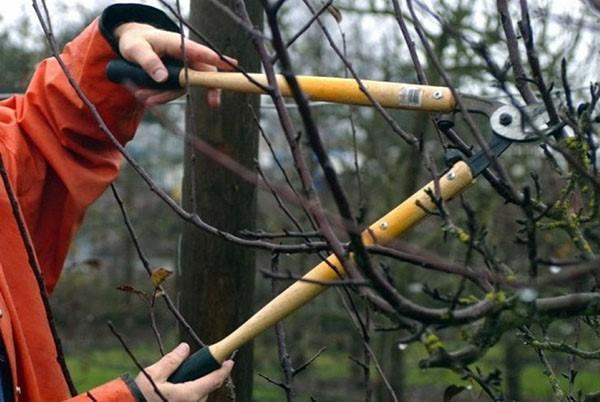Pruning pears in early spring
 Pear is a light-loving tree that does not tolerate crown thickening. Therefore, in order to increase the yield, pear pruning is carried out in early spring. But, unlike other fruit trees, the pear is pruned very superficially, since after strong pruning, deciduous buds quickly form young shoots, and the crown of the tree thickens even more.
Pear is a light-loving tree that does not tolerate crown thickening. Therefore, in order to increase the yield, pear pruning is carried out in early spring. But, unlike other fruit trees, the pear is pruned very superficially, since after strong pruning, deciduous buds quickly form young shoots, and the crown of the tree thickens even more.
Correct pruning of the pear
Only diseased, frozen or dried branches are completely removed, then those growing inside the crown.
If there are many branches growing inside the crown, then some of them can not be removed, but cut to a deciduous bud directed away from the trunk. Then such a branch will give a lateral shoot, on which flower buds will form, and eventually fruits will appear.
The pear, like all fruit trees, grows with the help of increments, the so-called "knees". On an annual shoot, a vegetative bud opens, the branch grows and at the same time becomes thinner, in the fall a new leafy bud is laid, and the shoot grows, thinning even more, every year the branch forms a new growth. The distance from kidney to kidney is usually the same. This distance is called "knee" or increment. Most varieties of pears do not form fruit buds on annual growths. But breeders have bred such varieties, whose growths form flower buds at the age of one. So that the still weak branches do not break off under the weight of the fruit, the load on such growths is reduced by shortening them by one third of the length of the one-year knee. Thus, the remaining fruit buds receive more nutrients, and the fruits increase in size.
Better to avoid forked branches. If one half of the forked branch grows inside the crown, then such a part is removed. Also, shoots that grow vertically upward and form an acute angle with the main skeletal branch are removed in order to avoid breaking during fruiting.
As with pruning any other fruit tree, care must be taken to keep the main root shoot taller than all other skeletal branches. For the pear to grow quickly, most of the nutrients must go to the main shoot. To form a new layer of skeletal branches, it is necessary to shorten the central shoot by one third. Then the process of formation of new lateral buds will start, and next summer these buds will bloom, and a new layer of skeletal branches will form.
In one article I read that a pear can be cut in autumn in September so that it has time to prepare for winter. But then she told me that it is better not to do it. Is it so?
In autumn, it is recommended to prune only adult pears belonging to winter-hardy varieties. At the same time, it is important to have time to finish the work before October, otherwise the tree will not have time to prepare before the frost.